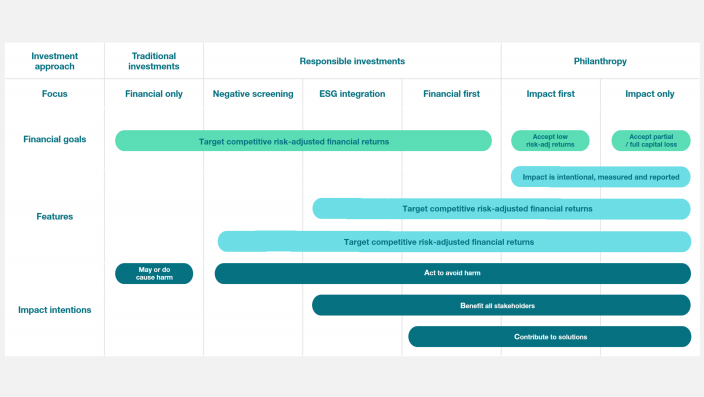How did impact investing arise?
'Impact Investing’ as a term was first coined in 2007 by the Rockefeller Foundation, but the practice itself has a long history that pre-dates this.
The approach at the centre of impact investing took some time to develop because shareholder primacy - the view that shareholder's needs should be prioritised over those of the other stakeholders of a company - was the prevailing theory from the 1970s.
However recent decades have seen increasing support for sustainability and impact investing due to growing global awareness of the climate crisis as well as other environmental, social and ethical issues.
In 2009, the Global Impact Investing Network (GIIN) was established to ‘champion impact investing and increase its scale and effectiveness around the world’. The word “impact” itself played an important role in crystalising the movement.
Impact investing and the spectrum of capital
Impact investing is a specific type of sustainability investing, along with environmental, social and governance (ESG) integration, exclusionary and inclusionary investing.
Perhaps confusingly, ‘ESG investing’ has become a catch-all term covering a range of investment objectives and outcomes. In many cases, it refers to ESG integration, in which environmental, social and governance metrics or data are considered within investment analysis and decision making.
Many investors use ESG ratings from specialist data providers to assist with this process but this may not provide the whole picture when the underlying data isn't fully understood. In addition, ESG metrics typically focus on how the company operates, rather than what the company produces.
Exclusionary and inclusionary approaches (also called positive or negative screening) screen investments based on certain characteristics, and often focus on the relative performance of companies by comparing them to their peers and may rely heavily on ESG data alone.
ESG integration alone typically leads to investment portfolios that are diversified across the economy, including the ‘best’ companies from inherently controversial sectors such as armaments, tobacco and oil and gas.
That's why impact investors like WHEB, intentionally invest for positive outcomes. For us, this means investing in companies that sell products and services which provide solutions to sustainability challenges and protect or enhance quality of life.
As a result. we maintain a clear and deliberate focus on analysing what a company is selling. Companies that sell products with negative impacts - such as armaments, tobacco and oil and gas - don't qualify as impact investments for us.
Impact investors may also take account of ESG issues in their analysis of the operational activities of potential investments. In all cases, impact investors will also consider the likely financial returns available.
Impact investing is ultimately about delivering positive social or environmental impact alongside a financial return.
At WHEB, we're not interested in short-term tactical trading: we believe that our focus on impact should support competitive financial returns over the long-term.
The spectrum of capital maps the range of sustainability investing strategies.

Combatting 'greenwashing'
Sadly, along with a rise in interest in sustainable investing, there's has also been a rise in ‘greenwashing’ in the industry.
This happens when investors portray their efforts as having greater positive sustainability outcomes than they do in reality, often for the purpose of marketing or public relations.
Ultimately, greenwashing risks undermining the movement towards sustainability investing and reducing the ability to enable positive outcomes in the real world.
The good news is that there are a range of new regulations and standards - many of which WHEB has contributed to - being developed by renowned organisations to try and combat greenwashing in sustainable investing.
This will require investment managers to be clear about their intentions, rigorous in their approach and provide transparent evidence that they've done what they say they'll do. This will be difficult for investment managers who are guilty of greenwashing, forcing them to alter their marketing or improve their practices.
Ultimately it means that the end investor can be confident that their money is being invested in the way they intended.
1 https://www.whebgroup.com/wheb-insights/boohoo-and-the-drunkards-search-for-esg-meaning/

